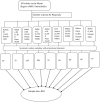Practice of Traditional Medicine and Associated Factors Among Residents in Eastern Ethiopia: A Community-Based Cross-Sectional Study
- PMID: 35774577
- PMCID: PMC9237408
- DOI: 10.3389/fpubh.2022.915722
Practice of Traditional Medicine and Associated Factors Among Residents in Eastern Ethiopia: A Community-Based Cross-Sectional Study
Abstract
Introduction: Although the Practice of traditional medicine is accorded great importance worldwide, it seems to face a notable challenge. A notable challenge is the lack of a reference standard for determining the appropriate utilization of traditional medicine for patients. There is little evidence about the usual utilized traditional medicine in the study area. Therefore, this study aimed to assess practice of traditional medicine and associated factors among residents in Eastern Ethiopia.
Methods: A community-based cross-sectional study was conducted from January 20, 2022 to February 20, 2022. About 818 study participants were recruited using a systematic random sampling technique. Data were collected by face-to-face interviews. The collected data were analyzed using Statistical Package for Social Sciences (SPSS) version 22 computer software. The association between an outcome variable and independent variables was assessed using binary logistic regression and the strength of association was presented using Adjusted Odd Ratio (AOR) with its 95% confidence intervals (CI).
Result: A total of 803 participants were included in the final analysis with a 98.2 % response rate. From the total study participants, 563 (70.1%) [95%CI: 66.8-73.3] had used traditional medicine in the past 6 months. Factors such as being farmer [AOR = 1.06; 95%CI: (1.03-3.7)], having a diploma degree or higher [AOR = 3.2, 95% CI (1.4-7.3)] and having no history of chronic disease [AOR = 0.21; 95% CI: (0.1-0.5)] were significantly associated traditional medicine practice.
Conclusion: The proportion of traditional medicine practice was high. The most commonly utilized traditional medicines were Damakase, Tenadam, Zingibil and Erate. A national health policy should give a great emphasize on rational utilization of traditional medicine.
Keywords: Eastern Ethiopia; Harari; practice; traditional medicine; utilization.
Copyright © 2022 Nigussie, Godana, Birhanu, Abdeta, Demeke, Lami, Gemechu, Eyeberu, Bogale, Dechasa, Getachew, Negash, Aliyi, Meseret, Kibret, Nigatu, Dirirsa, Gebremariam, Bayu, Abinew, Ali, Wondimneh, Alemu, Dilebo, Alemu and Dessie.
Conflict of interest statement
The authors declare that the research was conducted in the absence of any commercial or financial relationships that could be construed as a potential conflict of interest.
Figures
Similar articles
-
Utilization of modern contraceptives and associated factors among street women in Dire Dawa, Eastern Ethiopia: a mixed study.Reprod Health. 2021 Oct 26;18(1):212. doi: 10.1186/s12978-021-01263-z. Reprod Health. 2021. PMID: 34702303 Free PMC article.
-
Traditional bone setting service users and associated factors among people with trauma in Mecha district, Ethiopia.BMC Complement Med Ther. 2023 May 3;23(1):142. doi: 10.1186/s12906-023-03951-8. BMC Complement Med Ther. 2023. PMID: 37138250 Free PMC article.
-
Self-medication practice and associated factors among adult community members of Jigjiga town, Eastern Ethiopia.PLoS One. 2019 Jun 28;14(6):e0218772. doi: 10.1371/journal.pone.0218772. eCollection 2019. PLoS One. 2019. PMID: 31251745 Free PMC article.
-
The Study of Medicine.Med Chir Rev J Med Sci Anal Ser. 1823 Mar 1;3(12):806-832. Med Chir Rev J Med Sci Anal Ser. 1823. PMID: 29917527 Free PMC article. Review. No abstract available.
-
The Study of Medicine.Med Chir Rev J Med Sci Anal Ser. 1822 Dec 1;3(11):574-596. Med Chir Rev J Med Sci Anal Ser. 1822. PMID: 29917499 Free PMC article. Review. No abstract available.
Cited by
-
The role of traditional medicine in providing palliative care and improving the quality of life: a survey on patients' knowledge and utilization in Kumasi metropolis, Ghana.BMC Complement Med Ther. 2025 Jun 9;25(1):212. doi: 10.1186/s12906-025-04961-4. BMC Complement Med Ther. 2025. PMID: 40490758 Free PMC article.
-
Ethnobotanical study of medicinal plants in Dibatie district, Metekel zone, Benishangul Gumuz Regional State, western Ethiopia.J Ethnobiol Ethnomed. 2024 Sep 15;20(1):85. doi: 10.1186/s13002-024-00723-7. J Ethnobiol Ethnomed. 2024. PMID: 39278939 Free PMC article.
-
Traditional medicine use and associated factors in chronic patients in Jamalpur, Bangladesh: a cross-sectional study.Front Public Health. 2025 Feb 6;13:1548728. doi: 10.3389/fpubh.2025.1548728. eCollection 2025. Front Public Health. 2025. PMID: 39980915 Free PMC article.
-
Effect of integrating traditional care with modern healthcare to improve tuberculosis control programs in Ethiopia: a protocol for a cluster-randomized controlled trial.Trials. 2023 Sep 11;24(1):582. doi: 10.1186/s13063-023-07559-8. Trials. 2023. PMID: 37697429 Free PMC article.
-
Exploring the Anti-Inflammatory Potential of Ajuga integrifolia Leaves Extract: In Vitro Dual Inhibition of Cyclooxygenase and Lipoxygenase Enzymes.Adv Pharmacol Pharm Sci. 2024 Oct 28;2024:2938314. doi: 10.1155/2024/2938314. eCollection 2024. Adv Pharmacol Pharm Sci. 2024. PMID: 39502576 Free PMC article.
References
-
- Bodecker G. WHO Traditional Medicine, Better Science, Policy and Services for Health Development. Awaji Island: Imperial college press; (2000).
-
- Lariviere D. Nutritional Supplements Flexing Muscles as Growth Industry. Forbes. (2013). Available online at: http://www.forbes.com/sites/davidlariviere/2013/04/18/nutritional-supple...
-
- Barrett B, Kiefer D, Rabago D. Assessing the risks and benefits of herbal medicine: an overview of scientific evidence. Altern Ther Health Med. (1999) 5:40. - PubMed
-
- Elias AS, Bizatu M. Aspects of common traditional medical practices applied for under-five children in Ethiopia, Oromia Region, Eastern-Harargie District, Dadar Woreda, 2011 G.C. J Commut Med Health Educ. (2013).
MeSH terms
LinkOut - more resources
Full Text Sources
Miscellaneous


